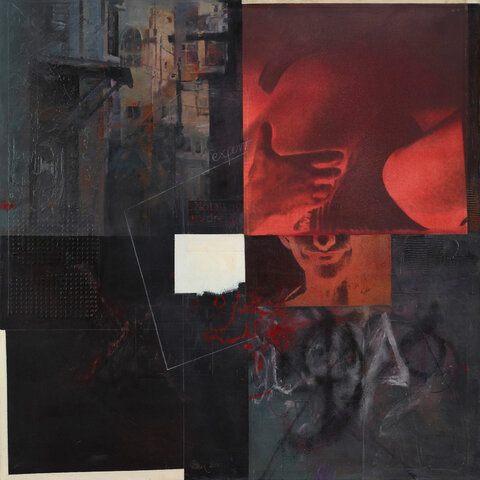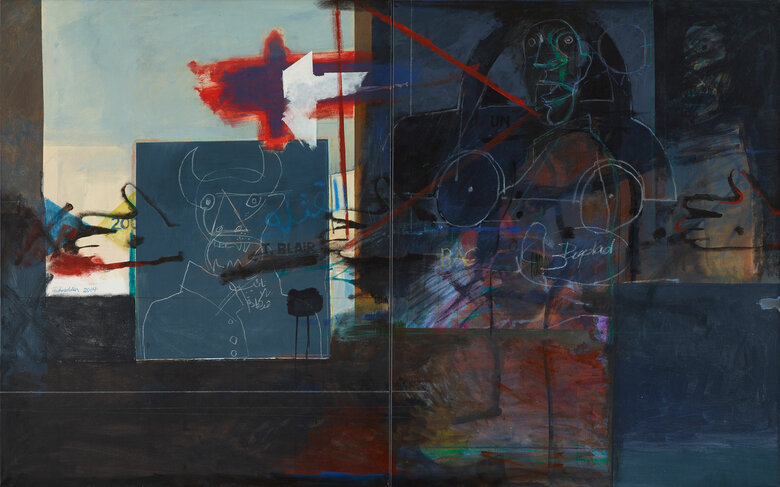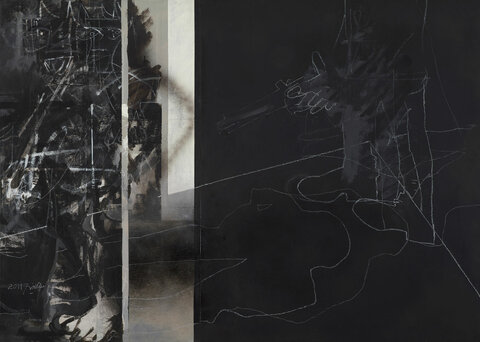Mohammad Muhraddin’s Untitled, 2009 shows a carefully orchestrated set of pictorial collages set onto a large-scale square wooden canvas, sub-divided into four equal quarters. In the upper left quarter, Muhraddin paints a hazy image of an archaic cityscape using dull muted tones of petroleum blue, grey, and dusty green, applied with soft brush strokes. The painting’s upper right quarter shows a printed, monochromatic red, photograph of a hand tightly grasping a human’s thigh. The equally red photographic image placed just beneath the hand within the lower right quarter of the painting’s composition shows a cropped face with an uncanny smile. Seemingly, in a state of total darkness, Muhraddin washes the lower left quarter of the canvas with a thick mass of burnt umber acrylic paint, contrasted with a white painted rectangular block at the centre of the overall square composition.
Through this equally distributed artwork, the eye roams over to absorb the painting’s intricate collaged elements and gradually unveils Muhraddin’s enigmatic messages. Each segment conceals a world of its own. In the first image of the cityscape, the artist obscures the city’s streets emphasizing instead its jammed buildings. The city is void of people and has no outlook beyond. In contrast to the sombre cityscape, the upper right segment depicts the warmth of human flesh. Washed in stark crimson red hues, the photograph’s close-up shot induces a sense of distress. Feelings of unease are further amplified through the image located just below. The lower right image demonstrates Muhraddin’s non-conformist style. The artist inscribes a set of incomprehensible scribbles, painted with black and white acrylic, vigorously splattered against a dark grey background. The left side also presents contradictions between the collaged image and the central white rectangle that holds all the pieces together.
Muhraddin’s inclusion of scribbles, numbers, and text are key elements of his work and artistic practice. Such visual elements hint to his intended message. Beneath the white central rectangle, Muhraddin wrote al Hadara al Arabiya, or the Arab Civilization in Arabic. He wrote this in crimson red with muddled brush strokes, making the words seem like blood seeping through a wounded soldier’s bandage. Again, above the central white block he included two statements: first not a dream, and second export, both in English. These statements resonate with the political struggles of his Iraqi homeland. The political unrest was certainly ‘not a dream’ to the Iraqi people who had suffered.
The visual elements in Untitled, 2009 are consumed by a haunting oneiric state; Muhraddin seems nostalgic and transfixed on the memory of his city, and his people. The year this piece was created was a period of endless unrest in Iraq. Marked by bombings, war, and immigration, Muhraddin intended to document the conflicting emotions of the Iraqi people. The dark, black, grey, and burnt umber, against a bloody crimson dominate his artwork, and reflect a doomed world. Moreover, roughly textured scrapings of the collaged painting’s surface further intensify its harshness.
In this piece, Muhraddin displays his proficiency in using unconventional mediums as a way to juxtapose collages reflecting his rebellious thoughts and experimental nature. Through the sharply split quarters, Muhraddin displays a traumatized memory of Iraq in screenshot-like scenes, only to evoke the disembodiment of a once populated city. Dark, cinematic, and nuanced, Untitled, 2009 is imbued with nostalgia and melancholy over what once existed, and despair from the bloody reality of Iraq’s muddled war.










